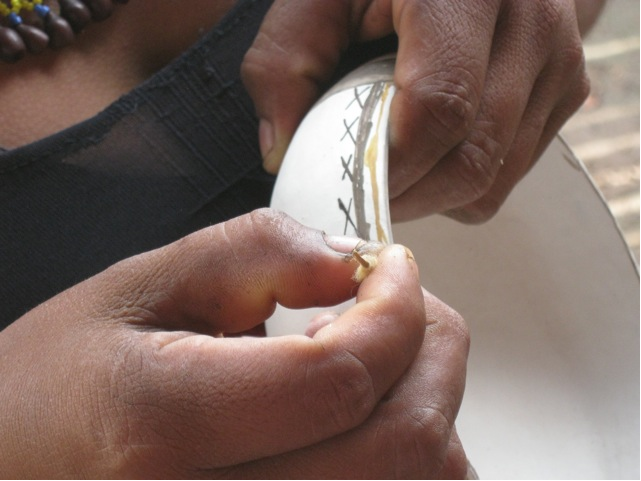 IHACC team member Marie-Pierre Lardeau recently returned from a field visit to the Peruvian Amazon study regions. She shared this notes from the field.
During the field work, Carol and I had the opportunity to learn more about some of the women’s traditional activities in the Shawi culture. Although Shawi women are traditionally more reserved and do not engage actively in conversations with strangers, they were very welcoming to us and let us in their homes. They absolutely amazed me with their knowledge of crafts, sowing, weaving and elaborate necklace making. Above all, what really impressed me was how almost everything is made completely by hand, with local materials.
IHACC team member Marie-Pierre Lardeau recently returned from a field visit to the Peruvian Amazon study regions. She shared this notes from the field.
During the field work, Carol and I had the opportunity to learn more about some of the women’s traditional activities in the Shawi culture. Although Shawi women are traditionally more reserved and do not engage actively in conversations with strangers, they were very welcoming to us and let us in their homes. They absolutely amazed me with their knowledge of crafts, sowing, weaving and elaborate necklace making. Above all, what really impressed me was how almost everything is made completely by hand, with local materials.
We were lucky enough to get to participate in one of these activities in Nuevo Progresso, one of the communities in which the IHACC project is working in. Santusa, a young mother, taught us one afternoon how to make mocawas, which are the traditional clay recipients used by the Shawi to eat and drink. Mocawas are made by women and have different shapes according to their intended use and are always painted and decorated. The ones that have the most elaborate designs are the ones for the masato, which is the traditional fermented yucca beverage. Masato is made with pride by women, and each house makes its own, it is the welcome beverage that is served in a mocawa when someone stops for a visit.
So on that Tuesday afternoon, Carol and I sat with Santusa who offered us one white clay bowl each so we could decorate them. I was so impressed by the fact that everything came from nature to make these bowls….The clay bowls themselves are made by hand: the clay is retrieved from the river, is mixed with ground pan de arbol, a starchy fruit found in the Amazon forest, shaped in bowls, cooked over the fire, and are then ready to be painted. The paints are made from various earth pigments found around the community that are mixed with river water and typically include ocre, black, cream and a deep brick colour. The paintbrush is made of strands of the women’s hair, attached to a small stick by cotton that is woven by hand. Santusa was pretty amused at Carol and I attempting to paint straight lines and make nice patterns, we often asked for her help to straighten things out, as we saw our lines getting incredibly thick or incredibly crooked! Even the most simple patterns that we thought we might be able to master seemed proved to be quite challenging! It was a good opportunity for us to laugh with Santusa, and learn more about the Shawi culture.
Another really interesting experience was learning about textile making with Norma, a young and friendly mother in Nuevo Progresso. She taught us how she makes the traditional fabric women wear in the Shawi communities: a long hand-woven fabric that is completely created without the use of any mechanical help. Every line of fabric is created by the expert hands of women who maneuver the long sticks they use in out of the fabric. Once the fabric is finished, it is then soaked in a mixture of grated leaf and water, which makes a natural burgundy dye. Some women use other pigments to colour their skirts but it seems the most popular one are burgundy and black. It takes a lot of patience and dexterity to create this fabric, because the first step actually involves making hundreds of threads by hand from the cotton that is picked around the community. This time, Carol and I didn’t attempt trying to make some fabric with Norma, as we saw that this was completely out of our league, and it gave us an incredible amount of appreciation for the work involved in the creation of clothes!
Marie-Pierre Lardeau


